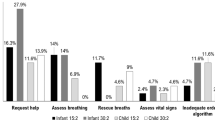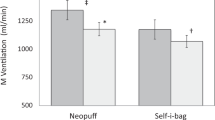Abstract
Objective:
To assess development of fatigue during chest compressions (CCs) in simulated neonatal cardiopulmonary resuscitation (CPR).
Study design:
Prospective randomized manikin crossover study. Thirty neonatal healthcare professionals who successfully completed the Neonatal Resuscitation Program performed CPR using (i) 3:1 compression:ventilation (C:V) ratio, (ii) continuous CC with asynchronous ventilation (CCaV) at a rate of 90 CC per min and (iii) CCaV at 120 CC per min for a duration of 10 min on a neonatal manikin. Changes in peak pressure (a surrogate of fatigue) and CC rate were continuously recorded and fatigue among groups was compared. Participants were blinded to pressure tracings and asked to rate their level of comfort and fatigue for each CPR trial.
Result:
Compared with baseline, a significant decrease in peak pressure was observed after 72, 96 and 156 s in group CCaV-120, CCaV-90 and 3:1 C:V, respectively. CC depth decreased by 50% within the first 3 min during CCaV-120, 30% during CCaV-90 and 20% during 3:1 C:V. Moreover, 3:1 C:V and CCaV were similarly preferred by healthcare professionals.
Conclusion:
Similarly, 3:1 C:V and CCaV CPR were also fatiguing. We recommend that rescuers should switch after every second cycle of heart rate assessment during neonatal CPR.
This is a preview of subscription content, access via your institution
Access options
Subscribe to this journal
Receive 12 print issues and online access
$259.00 per year
only $21.58 per issue
Buy this article
- Purchase on Springer Link
- Instant access to full article PDF
Prices may be subject to local taxes which are calculated during checkout

Similar content being viewed by others
References
Wyckoff MH, Perlman JM, Finer NN, Horbar JD . Cardiopulmonary resuscitation in very low birth weight infants. Pediatrics 2000; 106: 618–620.
Wyckoff MH, Salhab WA, Heyne RJ, Kendrick DE, Stoll BJ, Laptook AR . Outcome of extremely low birth weight infants who received delivery room cardiopulmonary resuscitation. J Pediatr 2012; 160: 239–244.
Kapadia V, Wyckoff MH . Chest compressions for bradycardia or asystole in neonates. Clin Perinatol 2012; 39: 833–842.
Wyckoff MH . Improving neonatal cardiopulmonary resuscitation hemodynamics: are sustained inflations during compressions the answer? Circulation 2013; 128: 2468–2469.
Kattwinkel J, Perlman JM, Aziz K, Colby C, Fairchild K, Gallagher J et al. Part 15: neonatal resuscitation: 2010 American Heart Association Guidelines for Cardiopulmonary Resuscitation and Emergency Cardiovascular Care. Circulation 2010; 122: S909–S919.
Berg RA, Hilwig RW, Kern KB, Ewy GA . "Bystander" chest compressions and assisted ventilation independently improve outcome from piglet asphyxial pulseless “Cardiac Arrest”. Circulation 2000; 101: 1743–1748.
Kern KB, Berg RA, Hilwig RW, Sanders AB, Ewy GA . Importance of continuous chest compressions during cardiopulmonary resuscitation improved outcome during a simulated single lay-rescuer scenario. Circulation 2002; 105: 645–649.
Schmölzer G, O’Reilly M, LaBossiere J, Lee T-F, Cowan S, Nicoll J et al. 3:1 compression to ventilation ratio versus continuous chest compression with asynchronous ventilation in a porcine model of neonatal resuscitation. Resuscitation 2014; 85: 270–275.
Schmölzer G, OReilly M, LaBossiere J, Lee TF, Cowan S . Cardiopulmonary resuscitation with chest compressions during sustained inflations: a new technique of neonatal resuscitation That Improves Recovery and Survival in a Neonatal Porcine Model. Circulation 2013; 128: 2495–2503.
Hamrick JT, Fisher B, Quinto KB, Foley J . Quality of external closed-chest compressions in a tertiary pediatric setting: Missing the mark. Resuscitation 2010; 81: 718–723.
Badaki-Makun O, Nadel F, Donoghue A, McBride M, Niles D, Seacrist T et al. Chest compression quality over time in pediatric resuscitations. Pediatrics 2013; 131: e797–e804.
Ashton A, McCluskey A, Gwinnutt CL, Keenan AM . Effect of rescuer fatigue on performance of continuous external chest compressions over 3 min. Resuscitation 2002; 55: 151–155.
Abella BS, Alvarado JP, Sandbo N, Vassilatos P, O'Hearn N, Wigder HN et al. Chest compression rates during cardiopulmonary resuscitation are suboptimal: a prospective study during in-hospital cardiac arrest. Circulation 2005; 111: 428–434.
Wyckoff MH, Christman C, Hemway RJ, Perlman JM . The two-thumb is superior to the two-finger method for administering chest compressions in a manikin model of neonatal resuscitation. Arch Dis Child Fetal Neonatal Ed 2011; 96: F99–F101.
Hemway RJ, Christman C, Perlman JM . The 3:1 is superior to a 15:2 ratio in a newborn manikin model in terms of quality of chest compressions and number of ventilations. Arch Dis Child Fetal Neonatal Ed 2012; 98: F42–F45.
Kleinman ME, de AR, Chameides L, Atkins DL, Berg R, Berg M et al. Part 10: Paediatric basic and advanced life support. Circulation 2010; 122: S466–S515.
Christman C, Hemway RJ, Wyckoff MH, Perlman JM . The two-thumb is superior to the two-finger method for administering chest compressions in a manikin model of neonatal resuscitation. Arch Dis Child Fetal Neonatal Ed 2011; 96: F99–F10.
Dorfsman ML, Menegazzi JJ, Wadas RJ, Auble TE . Two-thumb vs. two-finger chest compression in an infant model of prolonged cardiopulmonary resuscitation. Acad Emerg Med 2000; 7: 1077–1082.
Li ES, Cheung PY, Pichler G, Aziz K, Schmölzer GM . Respiratory function and near infrared spectroscopy recording during cardiopulmonary resuscitation in an extremely preterm Newborn. Neonatology 2014; 105: 200–204.
Bjørshol CA, Søreide E, Torsteinbø TH, Lexow K, Nilsen OB, Sunde K . Quality of chest compressions during 10 min of single-rescuer basic life support with different compression: ventilation ratios in a manikin model. Resuscitation 2008; 77: 95–100.
Haque IU, Udassi JP, Udassi S, Theriaque DW, Shuster JJ, Zaritsky AL . Chest compression quality and rescuer fatigue with increased compression to ventilation ratio during single rescuer pediatric CPR. Resuscitation 2008; 79: 82–89.
Cheung P-Y, Schmölzer G . Learning not to lean when you push … some hard-pressed issues of cardiac compressions during cardiopulmonary resuscitation of neonates. Resuscitation 2013; 84: 1637–1638.
Min MK, Yeom SR, Ryu JH, Kim YI, Park MR, Han SK et al. A 10-s rest improves chest compression quality during hands-only cardiopulmonary resuscitation: A prospective, randomized crossover study using a manikin model. Resuscitation 2013; 84: 1279–1284.
Solevåg A, Dannevig I, Wyckoff M, Saugstad O, Nakstad B . Return of spontaneous circulation with a compression:ventilation ratio of 15:2 versus 3:1 in newborn pigs with cardiac arrest due to asphyxia. Arch Dis Child Fetal Neonatal Ed 2011; 96: F417–F421.
Sugerman NT, Edelson DP, Leary M, Weidman EK, Herzberg DL, Vanden Hoek TL et al. Rescuer fatigue during actual in-hospital cardiopulmonary resuscitation with audiovisual feedback: A prospective multicenter study. Resuscitation 2009; 80: 981–984.
Dold S, Schmölzer GM, Kelm M, Davis PG, Schmalisch G, Roehr CC . Training Neonatal Cardiopulmonary Resuscitation: Can It Be Improved by Playing a Musical Prompt? A Pilot Study. Amer J Perinatol 2013; 31: 245–248.
Binder C, Urlesberger B, Schmölzer G, O’Reilly M, Pichler G . Human or monitor feedback to improve mask ventilation during simulated neonatal cardiopulmonary resuscitation. Arch Dis Child Fetal Neonatal Ed 2014; 99: F120–F123.
Wyllie J . Resuscitation of the depressed newborn. Semin Fetal Neonatal Med 2006; 11: 158–165.
Friess SH, Sutton RM, Bhalala U, Maltese MR, Naim MY, Bratinov G et al. Hemodynamic directed cardiopulmonary resuscitation improves short-term survival from ventricular fibrillation cardiac arrest. Crit Care Med 2013; 41: 2698–2704.
Acknowledgements
We would like to thank all participating neonatal healthcare professionals who contributed to this study with their own enthusiasm and effort, and Tze-Fun Lee for statistical assistance. ESL is supported in part by the Northern Alberta Clinical Trials and Research Centre Faculty of Medicine and Dentistry, University of Alberta, and Neonatal Research Fund, Northern Alberta Neonatal Program, Alberta Health Services. GMS is a recipient of a Banting Postdoctoral Fellowship, Canadian Institutes of Health Research and an Alberta Innovates–Health Solutions Clinical Fellowship.
Author information
Authors and Affiliations
Corresponding author
Ethics declarations
Competing interests
The authors declare no conflict of interest.
Rights and permissions
About this article
Cite this article
Li, E., Cheung, PY., O'Reilly, M. et al. Rescuer fatigue during simulated neonatal cardiopulmonary resuscitation. J Perinatol 35, 142–145 (2015). https://doi.org/10.1038/jp.2014.165
Received:
Revised:
Accepted:
Published:
Issue Date:
DOI: https://doi.org/10.1038/jp.2014.165



